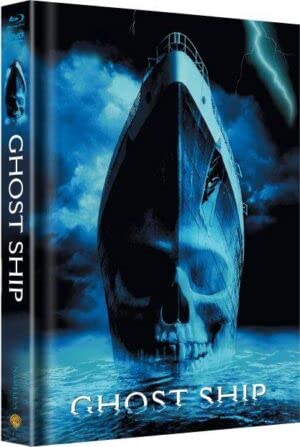Ghost ships have long intrigued those of us fascinated by the strange and unknown phenomena of the sea. The idea of a vessel adrift, abandoned, or lost at sea stirs our imaginations and evokes a blend of fear and curiosity. Recently, I had the opportunity to watch Ghost Ship again, a film that encapsulates this eerie allure, and I’m excited to share my thoughts on it.
Ghost Ship, directed by Steve Beck, was released in 2002. The film takes us on a chilling journey aboard a mysterious ship that emerges from the fog, bringing with it a harrowing tale of loss and terror. The narrative centers around a salvage crew that discovers an abandoned ocean liner, the Antonia Graza, which holds dark secrets within its haunted corridors.
Storyline
The story kicks off when a salvage crew, led by the rugged Captain Sean Murphy (played by Gabriel Byrne), comes across the ghostly vessel in the middle of the ocean. As they board the ship, they quickly realize that it is not just a derelict ship, but a vessel with a tragic history. The crew, consisting of characters like Epps (Julianna Margulies) and Dodge (Desmond Harrington), starts to uncover the haunting memories of the passengers who once sailed the Antonia Graza.
As they delve deeper into the ship, they encounter supernatural phenomena that lead to terrifying consequences. The film skillfully intertwines elements of horror and mystery, culminating in a series of events that keep viewers on the edge of their seats.
Cinematic Elements
Visuals and Special Effects
One aspect of Ghost Ship that stands out is its visual presentation. The film employs a variety of special effects that enhance the eerie atmosphere of the ship. The cinematography captures the desolation of the ocean and the haunting beauty of the Antonia Graza, making the ship itself a character in the story.
From the opening scene, where a gruesome accident occurs on the ship, to the ghostly apparitions that haunt the crew, the visuals are both striking and unsettling. The use of shadows and lighting plays a crucial role in creating tension, drawing viewers into the haunting world of the narrative.
Sound Design
The sound design of Ghost Ship is equally noteworthy. The score, composed by John Frizzell, provides an unsettling backdrop that amplifies the film’s horror elements. The creaking of the ship, the whispers of the lost souls, and the eerie silence of the ocean all contribute to a rich auditory experience that enhances the overall atmosphere.
Themes Explored
Ghost Ship delves into various themes, including loss, redemption, and the consequences of past actions. The story brings to light the idea that the past can haunt us, both literally and metaphorically. As the characters confront the ghosts of the ship, they also grapple with their own personal demons.
The Human Element
One of the film’s strongest aspects is the exploration of the human element within the horror. Each character has their backstory, and as they face the supernatural elements of the ship, we see how their pasts shape their actions. This adds depth to the narrative, making it more than just a typical horror film. The emotional struggles of the crew elevate the stakes, allowing viewers to connect with them on a deeper level.
Critical Reception
When Ghost Ship was released, it received mixed reviews from critics. Many praised its atmospheric qualities and visual effects but criticized the plot for being somewhat predictable. However, from my perspective, the film successfully captures the essence of a ghost ship narrative, and while it may follow certain horror tropes, it does so with style.
The blend of horror and mystery is particularly appealing to those of us who appreciate the strange and unexplained. The film’s ability to evoke fear through its setting and atmosphere is commendable, and I believe it has earned its place among cult classic horror films.
Comparisons to Other Ghost Ship Films
In the realm of cinema, Ghost Ship is not alone in its portrayal of ghostly maritime tales. Films like The Fog (1980) and The Shining (1980) also explore similar themes of isolation and the supernatural. However, what sets Ghost Ship apart is its focus on the ship as a central character, allowing the audience to immerse themselves in its haunted history.
The Allure of the Unknown
For those of us drawn to the strange and unexplainable, Ghost Ship serves as a reminder of the mysteries that lie beneath the ocean’s surface. The concept of a ghost ship resonates with our fascination for lost vessels and the unknown, echoing tales of ships like the infamous Mary Celeste or the USS Cyclops.
Conclusion
In conclusion, Ghost Ship is a film that effectively captures the essence of the ghost ship genre. With its compelling visuals, atmospheric sound design, and exploration of human emotions, it offers an engaging experience for those intrigued by the strange and unknown phenomena of the sea. While it may not be perfect, it delivers enough thrills and chills to make it worth a watch.
If you find yourself captivated by tales of lost vessels and the haunting mysteries of the ocean, I encourage you to give Ghost Ship a viewing. It’s a film that invites you to explore the depths of fear and the shadows of the past, offering a chilling reminder that some stories never truly end.
<iframe width="560" height="315" src="https://www.youtube.com/embed/a7xNXTpQA5Q?si=6M8ZY3T_jp3xXvCS" title="YouTube video player" frameborder="0" allow="accelerometer; autoplay; clipboard-write; encrypted-media; gyroscope; picture-in-picture; web-share" referrerpolicy="strict-origin-when-cross-origin" allowfullscreen></iframe>




.jpg?w=100&resize=100,70&ssl=1)
